Out Of Time
Sr. Member
- Apr 10, 2019
- 326
- 876
- Primary Interest:
- All Treasure Hunting
Amazon Forum Fav 👍
Upvote
0
Follow along with the video below to see how to install our site as a web app on your home screen.
Note: This feature may not be available in some browsers.
 Gary
GaryI think it's probably just a result of implement damage. The only "flaking" is from just above the heart line of your palm to just below your third finger in the first picture. The equally spaced lines along the edge below that are just part of how the glass broke originally. I've found points that had very fresh, what looked like pressure flaking along a short space of the blade edge that more than likely were caught just right by a harrow. That would be my guess in this case, since everywhere on the piece looks like a broke piece of glass except for that 1/2" to 5/8" spot. Seeing it in person might make all the difference though.
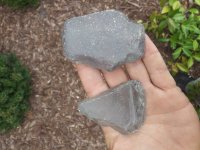
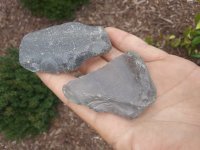
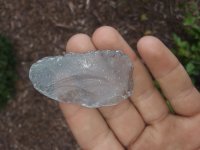
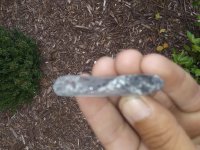
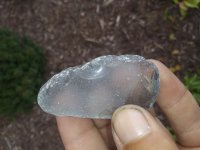
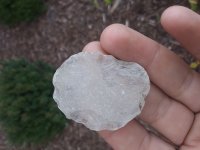

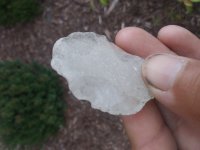
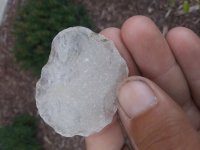
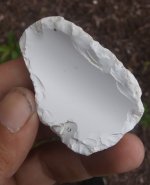
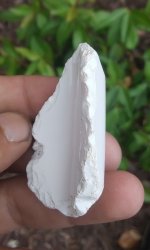
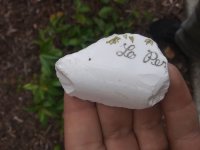
I think it is worked. I find that thick glass worked to here in th Sf Bay area. I also find old ceramic pieces that look like knives and are bifacially worked.
Here are a couple of thick pieces i thought could be preforms as well. There is a lack of edgework but there are some flake scars on both sides of the edges
These may deem questionable i also find them in a creek and they remind me of your piece but your piece has some more obvious features so to me these 2 pieces are questionable.
View attachment 1754407
View attachment 1754408
This one looks more finished and has flake scars on both sides and a nice edge.
View attachment 1754411View attachment 1754412
View attachment 1754413
Possible scraper
View attachment 1754414View attachment 1754414View attachment 1754415View attachment 1754416
Ceramic piece with a knife shape. It looks to be some obvious edgework on both sides.It has some French or some other type of European language on it.
View attachment 1754417
View attachment 1754418
View attachment 1754419
I have some better ones ill post if you would like. Just saw some relation to your piece being the thick glass.
Those are very interesting and cool.
Distinct resemblance to my piece - but even more worn.
Personally, I think they are artifacts but I can see that there's room for debate.
Close, in-the-hand inspection tells you more than pictures.
It's remarkable how much wear these Californian creeks can inflict on material.
The one I hunt in Napa is small and seasonal but manages to wipe obsidian clean of flake scars.
Are you hunting by the bay? What are the creeks like there?
It's always interesting to see California artifacts (which seem a little under represented in this forum), so please post anything/everything.
..It seems to me the thickness of the glass puts it in the time frame - say around 1875 or earlier back to contact...Maybe, I'll try to post some better pics as you won't get the chance to see it in person.

guys...you should get to the beach more often....there is nothing posted here that i haven't seen busted up on the beach. The color of the glass (clear) is also an indication of youth not age...
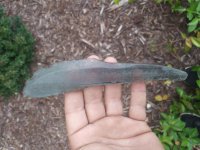
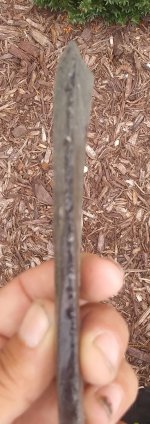
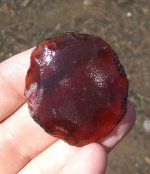
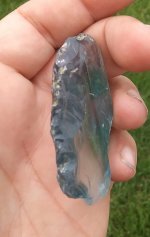
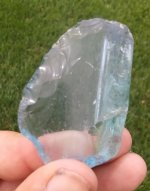
Not sure there’s a way to prove that it wasn’t recently knapped by somebody trying to learn the skill
I don't find flaked tools very often and I listen and respect your opinions when you speak. I have sent a few pieces to different people to get an in hand opinion. A lot of pieces i find are almost perfect circles with edge work all the way around.
Before i got into hunting Indian artifacts i would hunt bottles and glass. In creeks glass doesn't get busted up as much as pieces i find at the site i hunt. Most old broken glass pieces do not show any busted up edges at all the breaks are just like breaks you see from broken bottle glass that are recent.
As far as the age of the glass pieces including the original piece posted by Out of Time. The glass is well in line with glass that was worked by Natives here. Ishi was working glass in the early 1900's. Tribes had camps well into the 1900's here. So the Archaeology is a little different in California then the rest of the states.
Not at all trying to convince you on the above pieces or create a negative debate because the pieces are definitely debatable. Here are some other pieces that i have found in the same area. Aslo id be more then happy to send you some pieces to look at in hand.
It's hard in the pics to see the edge work but you have to admit it some are pretty knife like LOL! Also on all of the pieces above and below the busted up edges are only on what would be the cutting edge not the other sides. I can also show you the edges that are straight that have little chips like they were scored and snapped. I could be wrong.
View attachment 1756101 View attachment 1756104View attachment 1756107View attachment 1756113View attachment 1756115
There was a pic i tried to erase not sure if it will show up. Some how it found it's way without choosing it haha.
Have a good one UncleMac